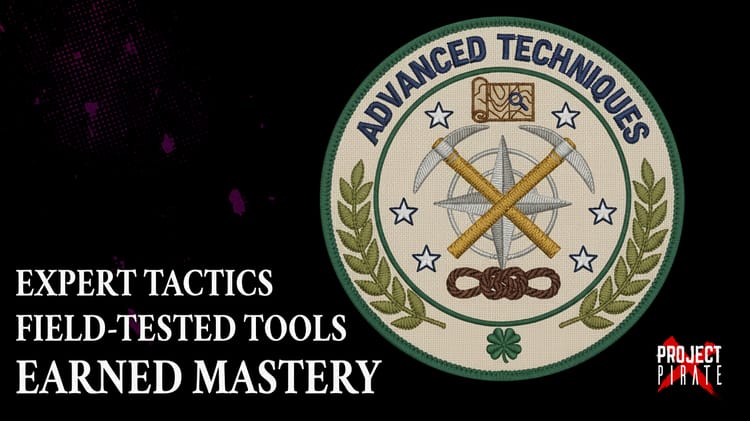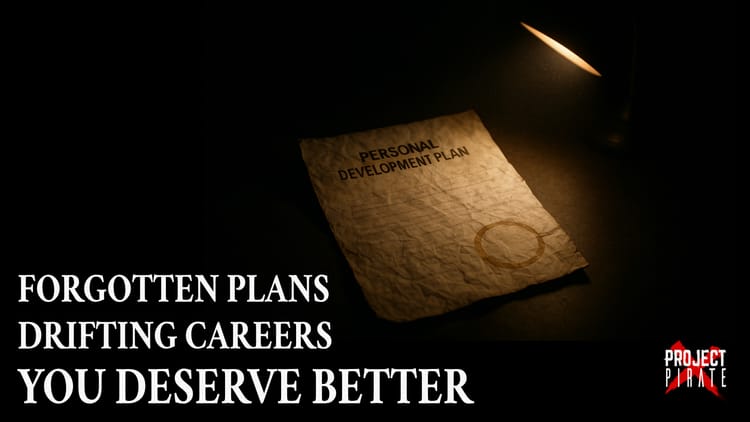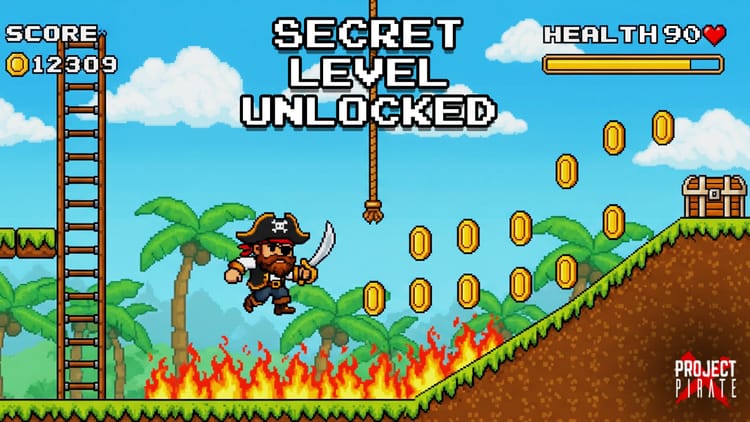Career as a Project (CaaP): Part 2 - Building Your Visual Charter
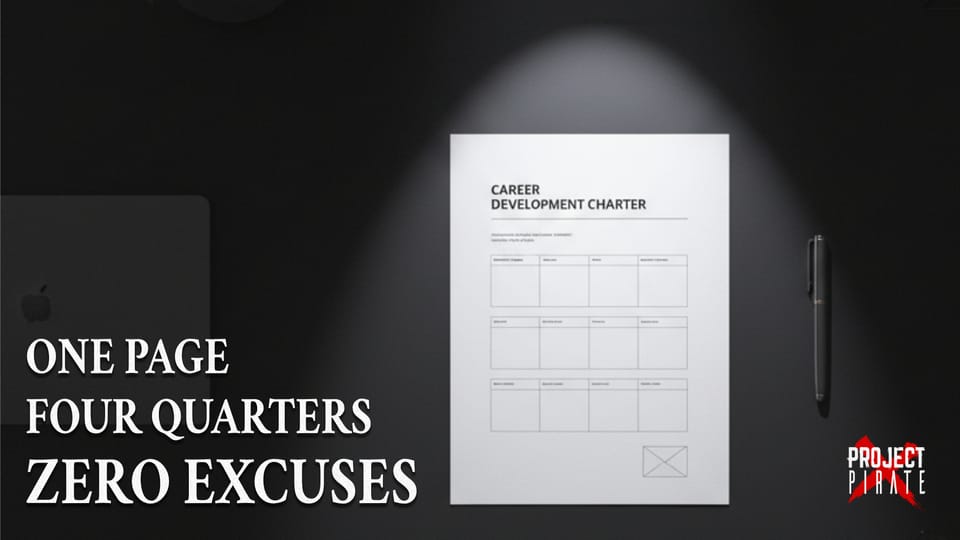
Why your forgotten PDP isn't working - and how to create a career development tool you'll actually use.
In Part 1, we explored the career paradox: professionals who manage complex projects with rigour somehow manage their own advancement with vague hope.
The solution? Career as a Project (CaaP) - applying the same methodological discipline to your career that you demand from critical deliveries.
But methodology without tools remains theory. This is where CaaP transforms from concept to practice.
Your Career Development Charter is the first practical tool of the CaaP framework - a visual command centre that replaces forgotten PDPs with active career management.
The Problem: PDPs as Performance Theatre
Your Personal Development Plan (PDP) sits in a folder somewhere - or worse, trapped in an HR system like PeopleSoft or Workday, hidden behind three menu clicks you can't remember.
You filled it out because someone told you to. You ticked the box. Job done. Until your next performance review, when you'll scramble to remember what you wrote and why any of it mattered.
That PDP represents everything wrong with how individuals approach career development:
Disconnection: Your PDP bears no relation to where you actually want your career to go. It's filled with generic aspirations like "improve leadership skills" - vague enough to satisfy HR, meaningless enough to ignore.
Invisibility: Buried in systems or folders, your PDP isn't something you reference. It's stored in a dark location, left to wither, decay and eventually die till its rebirth 12 months later.
Passivity: Traditional PDPs respond to last year's performance review rather than drive towards next year's goals. They document what you should fix, not what you aim to become.
No Active Management: You wouldn't manage a critical project by writing a plan once and reviewing it annually. Yet that's exactly how most professionals "manage" their careers.
This is task completion theatre. And it's expensive.
How expensive? The professional who navigates intentionally versus one who drifts can see a six figure difference in lifetime earnings, 3-5 years of career acceleration and the gap between reaching senior leadership or plateauing in middle management. While you treat career development as an afterthought, more intentional professionals are compounding progress.
The Solution: Your Career Development Charter
What if your career development plan was something you actually used?
Not buried in a system. Not forgotten until someone asks about it. But visible, active, and managed with the same discipline that makes you effective at work.
Your Career Development Charter is a single-page framework that turns forgotten PDPs into active career management using principles you already trust from project delivery.
Career as a Project: Framework in Practice
Traditional project management teaches us that successful delivery requires:
- Clear scope: Specific outcomes, not vague aspirations.
- Structured phases: Breaking work into manageable timeboxes.
- Visual tracking: Making progress impossible to ignore.
- Regular reviews: Continuous assessment and adjustment.
- Stakeholder management: Ensuring decision-makers understand value.
Your Career Development Charter applies every one of these principles to your advancement. It's project methodology applied to the most important initiative you'll ever lead.
Building Your Career Development Charter
The Four Core Themes
Just as effective Project Managers break initiatives into deliverable phases, your Charter uses a 12-month tactical view broken into quarters, structured around four development themes - which include up to two individual themes unique to your own career and development goals:
1. Visibility & Communications (Start Here)
Why this comes first: You already have capabilities. The question is whether decision-makers know about them. This isn't unseemly self-promotion - it's strategic stakeholder management.
As we explored in our article on Project PR - no one else is responsible for selling your achievements. If you're waiting for your work to speak for itself, you're waiting for advancement that may never come.
History doesn't remember silent voyages, no matter how skilfully navigated. ⚓️
Not "be more visible"
But "Present at two industry conferences" or "Publish monthly insights on strategic priorities"
2. Network Development
In Project Management, stakeholder mapping isn't optional - it's fundamental to delivery success. Your career project requires the same discipline.
Which professional relationships need cultivation? What communities should you engage with? Who are the stakeholders whose support you'll need for advancement?
Not "network more"
But "Establish quarterly conversations with three directors in target function" or "Join and contribute to industry working group"
3. Skills & Training
What capabilities do you need to build? Which certifications or technical expertise unlock advancement? What's the timeline for each?
"Become more technical" isn't a project outcome you'd accept at work - neither should it be acceptable in your career project.
Not "become more technical"
But "Complete AWS certification by Q3" or "Lead three agile transformations by year-end"
4. Your Personal Themes
Add one or two themes specific to your advancement goals. Leadership development? Cross-functional experience? Industry expertise? Your Charter reflects your unique strategy.
A Real Charter: Sarah's Example
Sarah - Senior Project Manager, Financial Services, wants to become Programme Director
Q1:
- Visibility: Present at internal PMO forum on risk management approach.
- Network: Monthly coffees with 3 programme directors.
- Skills: Enrol in Managing Successful Programmes (MSP) course.
- Leadership: Volunteer to mentor 2 junior PMs.
Q2:
- Visibility: Publish article on programme governance in industry journal.
- Network: Join Programme Management SIG, attend 2 events.
- Skills: Complete MSP certification.
- Leadership: Lead cross-functional workshop on portfolio prioritisation.
Q3:
- Visibility: Speak at external conference on transformation delivery.
- Network: Establish relationship with CIO's office on strategic initiatives.
- Skills: Complete AWS Cloud Practitioner Essentials (supports Data Centre to Cloud migration programme).
- Leadership: Propose and secure sponsorship for PMO capability framework.
Q4:
- Visibility: Host internal masterclass on stakeholder management.
- Network: Build coalition of support for programme director opportunity.
- Skills: Complete financial management for non-financial managers.
- Leadership: Successfully deliver capability framework, gain exec visibility.
Sarah's Charter sits on her desk. When her director asks her to take on additional work that doesn't build programme-level skills, she can evaluate it against her critical career development path. When a speaking opportunity appears, she can validate if it serves her visibility theme. When her mentor suggests a certification, she assesses whether it accelerates her timeline based on her company's strategic direction.
Her Charter turns "I want to progress" into "Here's exactly what I'm building, quarter by quarter - capability on top of capability."
Know Where You Stand: Your Career Project Diagnostic
Before building your Charter, run a quick SWOT analysis on your current position: strengths to leverage, weaknesses to address, opportunities to pursue, threats to mitigate. This diagnostic feeds directly into your Charter themes - turning self-awareness into specific quarterly actions.
Vision: Who Do You Want to Become?
The CV from the Future
Imagine yourself three or five years ahead. Future you hands you their CV. What does it say?
- What did you achieve? Which projects carried your name?
- What roles did you hold? What progression is evident?
- What skills did you gain? What became your calling card?
- What did you give back? How did you contribute?
Don't just imagine it, write it! This future CV becomes your north star. The clearer it is, the better you can work backwards to deconstruct it and identify what you need to build.
The Postcard from the Future
Some people think in stories rather than bullet points. If that's you, imagine future you sends a postcard describing their career and life.
What does it say about where they work and what they do? How they spend their time? What gives them satisfaction? What they're known for?
Both techniques transform "I want to be successful" into "I lead transformation programmes with P&L accountability for £10M+ initiatives."
From Annual to Quarterly: Active Management
Review your Charter every quarter and ask:
- What's working? What's blocked?
- Are these goals still the right goals?
- What needs course correction?
Treat it like a live project - because it is! New opportunities get evaluated against the plan. Does this accelerate advancement or create distraction?
Update as you learn. When assumptions prove wrong, adjust. The Charter evolves with your understanding.
Make it visible. The plan isn't buried where it can be forgotten. It's posted where you can see it, reference it, use it to guide decisions.
This active management compounds progress. Skills reinforce relationships. Visibility amplifies expertise. Each quarter builds on the last.
After 90 days, if you can't articulate next Quarters priorities in 30 seconds, your Charter isn't working. Fix it.
Why This Works
The Career Development Charter succeeds where traditional PDPs fail:
Visual Management: One page you can see beats a multi-page document buried in a system.
Structured Delivery: Themes give you clear work streams rather than vague aspirations.
Active Iteration: Quarterly reviews mean you're always current, always adjusting.
Stakeholder Clarity: Created for your goals, not HR's requirements. You're both sponsor and delivery lead.
When professionals adopt this approach, they stop drifting. They know where they're going and how they're progressing. They can articulate their value because they're systematically building it.
Quick Start: Your 20-Minute Charter
Don't wait for the perfect plan. Start imperfect, improve quarterly. Before you move on to anything else, do this:
Seriously. Stop reading. Open your phone's notes app right now. Four words: Visibility. Network. Skills. Personal.
Under each one, write ONE specific, measurable goal for the next 90 days:
- Visibility: One way you'll increase decision-maker awareness.
- Network: One relationship you'll build or strengthen.
- Skills: One capability you'll develop.
- Personal Theme: One area specific to your advancement.
That's it. You've just created Charter v0.1.
Print it. Post it where you'll see it daily.
Now celebrate this moment. You've just set out with a known destination and purpose behind it. You're navigating instead of drifting. Now expand your vision to cover the next 12 months... you now have V1. Take a photo of your Charter and share it with one trusted person - tell them you're managing your career with the same discipline you bring to critical projects.
In 90 days, assess what worked, what didn't, and refine the following quarter's plan.
The difference between professionals who advance strategically and those who plateau isn't the quality of their plans. It's whether they have a plan at all, and whether they use it.
Your Charter doesn't need to be perfect. It needs to be visible, specific and reviewed regularly (quarterly at a minimum).
Direction doesn't require permission. It requires visibility, intent and course correction. The compass is in your hands.
What's Next: Managing Your Charter
The Career Development Charter gives you the visual tool. But having a navigational chart isn't the same as knowing how to navigate.
In Part 3, we'll explore how to actively manage your Charter using the five core disciplines of Career as a Project:
- Defining clear scope for your career goals.
- Understanding how activities unlock others.
- Deciding where to invest your time and energy.
- Managing risks that could derail progress.
- Tracking advancement with real discipline.
These disciplines transform your Charter from a planning document into an operational system.
The Career as a Project (CaaP) Series:
- Part 1: The Career Paradox -Why You Need CaaP
- Part 2: Your Career Development Charter - CaaP's Visual Tool (Current)
- Part 3: The Five Disciplines - Managing Your Charter with CaaP Methodology
- Part 4: CaaP in Practice - Advanced Techniques & Case Studies
Join the Crew - where professionals chart their careers with the same precision they demand in their critical work.
